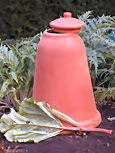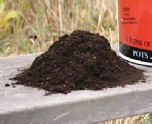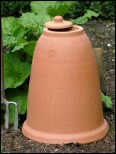




The rhubarb triangle is officially the triangular area named due to its history of rhubarb growing. The location of the ‘triangle’ is sometimes described as the triangular area formed between the three cities of Leeds, Wakefield and Bradford, (the green triangle of the map), other sources of information give the points of the triangle as Leeds, Morley and Wakefield, (the blue triangle on the map). However, the largest area of rhubarb cultivation falls outside of both of these ‘triangles. The rhubarb triangle is more accurately the triangular area of land between Morley, Wakefield and Rothwell (the red triangle on the map). Much rhubarb is grown around the village of Carlton. In fact recently there had been some suggestion that Carlton change its name to Rhubarb!
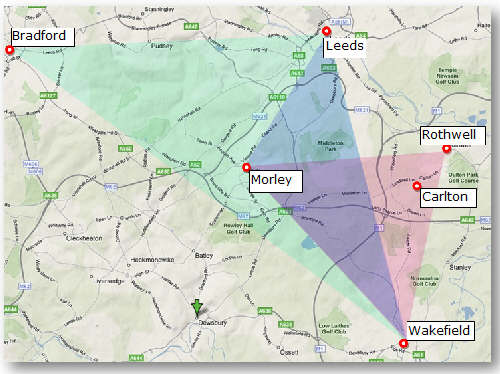
Each year a Rhubarb Festival is held in Wakefield, the capital city of the rhubarb triangle, with people arriving from all over the country to attend. During the festival demonstrations of cookery with rhubarb and visits to local world famous forcing sheds are on offer. Although at one time when there were around two hundred rhubarb growers in the area, the secrets of successful rhubarb growing was a closely guarded secret and visitors would be kept well away from the forcing sheds.
The soil in the area and the amount of rainfall meant that the area was suitable for growing rhubarb successfully. Also being a mining area there was plentiful supplies of soot and ash which could be used as a soil conditioner and also a supply of cheap fuel with which to heat the forcing sheds. The area also boasted a large number of small market gardens. There were many textile mills in the West Yorkshire area and the waste from the mills mixed with horse manure made an ideal organic mulch. As the material decayed it released nitrogen to the roots of the plant.
For over 150 years rhubarb has been important to the area. Special rhubarb trains used to operate daily between Wakefield and London. The last of the ‘Rhubarb Express’ trains left Wakefield in 1966.
Originally rhubarb grew in Siberia where winters are cold and wet. Apparently it was originally grown in the Wakefield area as an ornamental garden plant. Even today plants from the same family, rheum, are grown as ornamental plants. In is also possible that original rhubarb was eaten for medicinal purposes as a laxative. In the 13th century rhubarb was four times more expensive than opium.
In the 19th century rhubarb was being grown by market gardeners in the Wakefield area as a fruit (even though technically it is a vegetable – a fruit is the part of the plant that holds the seeds whereas we eat the stem of the rhubarb plant), for use in jams and pies.
Legend has it that the art of forcing rhubarb was stumbled upon by accident when a chimney pot was accidentally left over a clump of rhubarb and the plant stems strained to grow and reach the light. On eating the stems they were found to be sweeter and more delicate than usual and so the art of growing rhubarb in the dark was born!
Around this time rhubarb began to be grown indoors in special forcing sheds. The name shed doesn’t really adequately convey the idea of these vast low roofed, windowless structures. Here rhubarb was grown in warm, dark conditions. Even now the rhubarb sheds are lit by candlelight and workers gather rhubarb in the gloom. When the rhubarb roots are taken into the warmth of the forcing sheds they are fooled into thinking that it is spring and this caused the buds to form quickly. In the quiet of the sheds it is said that the workers can actually hear the rhubarb growing.
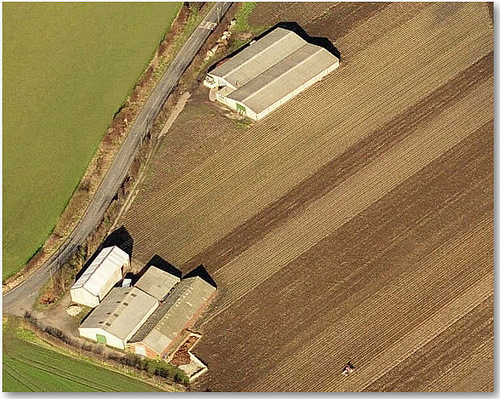
The darkness is essential to the production of the pale forced rhubarb much favoured by restaurants. The darkness means that all the plants energy is put into the growth of long pale stems rather than lush green leaves. This produces a sweeter crop.
Rhubarb plants are grown in the open for two years to build up energy within the plant. They are then taken into the forcing sheds where they are cropped for a year before they are thrown away as forcing severely weakens the plants.
About 90% of the world’s forced rhubarb was grown in the rhubarb triangle. At one time it was the only fresh fruit/vegetable available in the winter but after World War II more exotic fruits from overseas became available which caused a decline in its popularity. The two hundred growers have diminished to about twelve.
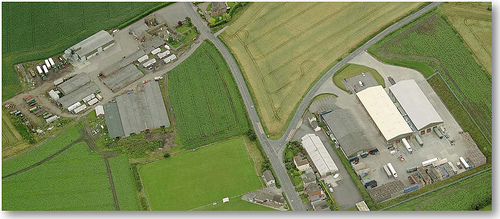
Nowadays the popularity of rhubarb is once again on the increase as people’s tastes change and sharp fruits are once more in ‘fashion’. This renaissance has maybe saved the rhubarb triangle from fading into extinction.
Rhubarb Tour
Click here for everything you have NEVER needed to know about rhubarb!
Click here to visit another rhubarb grower near to us
Fancy trying to grow your own forced rhubarb?
|
|
Terracotta Rhubarb Forcer
Not only is this elegant Terracotta Rhubarb Forcer made from Yorkshire hand thrown clay, but it offers great protection too, being frost proof up to -15ºC. With a lifetime frost-proof guarantee and standing a generous 47cm tall x 38.5cm wide.
Click here
|
|
|
Rhubarb Forcer
This polyethylene version of the Rhubarb Forcer is finished in the same traditional style of the terracotta forcers but is a fraction of the cost at only £54-95 - it's lightweight, easily portable and also frost proof.
Click here
|
|
Sheep's Wool Compost
Sheep's Wool Compost is an excellent eco-friendly peat-free garden compost that mixes bracken and sheep’s wool to help retain water while releasing nutrients to feed flowers, fruit and vegetables throughout the growing season. The idea originated from old gardening books that talked of wool's natural ability to hold water to itself, and provide long term nutrient release - wool is still famously used in the 'Rhubarb Triangle' of Yorkshire.
Click here
|
|
